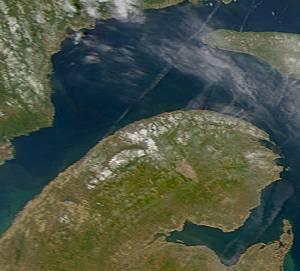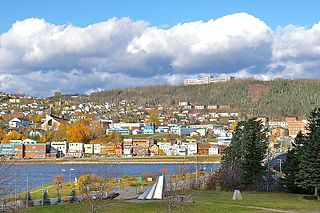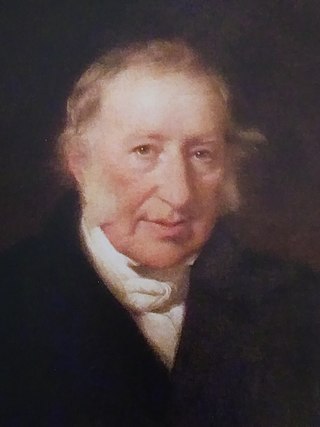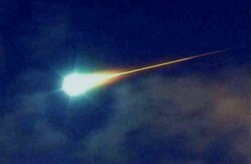Related Research Articles

A meteorite is a solid piece of debris from an object, such as a comet, asteroid, or meteoroid, that originates in outer space and survives its passage through the atmosphere to reach the surface of a planet or moon. When the original object enters the atmosphere, various factors such as friction, pressure, and chemical interactions with the atmospheric gases cause it to heat up and radiate energy. It then becomes a meteor and forms a fireball, also known as a shooting star; astronomers call the brightest examples "bolides". Once it settles on the larger body's surface, the meteor becomes a meteorite. Meteorites vary greatly in size. For geologists, a bolide is a meteorite large enough to create an impact crater.

Jacques Cartier was a French-Breton maritime explorer for France. Jacques Cartier was the first European to describe and map the Gulf of Saint Lawrence and the shores of the Saint Lawrence River, which he named "The Country of Canadas" after the Iroquoian names for the two big settlements he saw at Stadacona and at Hochelaga.

The Gaspé Peninsula, also known as Gaspesia, is a peninsula along the south shore of the St. Lawrence River that extends from the Matapedia Valley in Quebec, Canada, into the Gulf of St. Lawrence. It is separated from New Brunswick on its southern side by Chaleur Bay and the Restigouche River. The name Gaspé comes from the Mi'kmaq word gespe'g, meaning "end", referring to the end of the land.

Gaspé is a city at the tip of the Gaspé Peninsula in the Gaspésie–Îles-de-la-Madeleine region of eastern Quebec in Canada. Gaspé is located about 650 km (400 mi) northeast of Quebec City, and 350 km (220 mi) east of Rimouski. As of the 2021 Canadian Census, the city had a total population of 15,063.

La Côte-de-Gaspé is a regional county municipality on the Gaspé peninsula in eastern Quebec, Canada, part of the Gaspésie–Îles-de-la-Madeleine region. The seat is Gaspé.
Bonaventure—Gaspé—Îles-de-la-Madeleine—Pabok was a federal electoral district in Quebec, Canada, that was represented in the House of Commons of Canada from 1997 to 2004.

Gaspésie–Îles-de-la-Madeleine is an administrative region of Quebec consisting of the Gaspé Peninsula (Gaspésie) and the Îles-de-la-Madeleine. It lies in the Gulf of Saint Lawrence at the eastern extreme of southern Quebec. The predominant economic activities are fishing, forestry and tourism.

The Cape York meteorite, also known as the Innaanganeq meteorite, is one of the largest known iron meteorites, classified as a medium octahedrite in chemical group IIIAB. In addition to many small fragments, at least eight large fragments with a total mass of 58 tons have been recovered, the largest weighing 31 tonnes. The meteorite is named after the location where the largest fragment was found: 23 miles (37 km) east of Cape York, in Savissivik, Meteorite Island, Greenland.

Philippe-Joseph Aubert de Gaspé was a Canadian lawyer, writer, and seigneur. He is known chiefly for his novel Les Anciens Canadiens, considered the first classic of French Canadian fiction.

The Montreal–Gaspé train was a thrice-weekly passenger train operated by Via Rail between Montreal and Gaspé, Quebec. Passenger rail service to Gaspé is to be restored in 2026.

Cégep de la Gaspésie et des Îles is a bilingual college of general and vocational education, with an English section, in Gaspé, Quebec, Canada. The CEGEP is affiliated with the ACCC, and CCAA.

Charles Robin was an entrepreneur from the Isle of Jersey who traded between the maritime region of Canada and the British Isles.

A meteorite fall, also called an observed fall, is a meteorite collected after its fall from outer space was observed by people or automated devices. Any other meteorite is called a "find". There are more than 1,300 documented falls listed in widely used databases, most of which have specimens in modern collections. As of February 2023, the Meteoritical Bulletin Database had 1372 confirmed falls.

Sainte-Thérèse-de-Gaspé is a municipality in the Gaspésie-Îles-de-la-Madeleine region of the province of Quebec in Canada. It is the smallest municipality, in land area and population, of the Le Rocher-Percé Regional County Municipality.
James Russell Keays was a Canadian industrialist and politician. He was a mayor in Quebec and later a Progressive Conservative party member of the House of Commons of Canada.
Chambord is an iron meteorite found in Quebec.
Lac Dodon is an iron meteorite discovered by Roland Octerneau of Montreal on rural private property near Lac Dodon, Saint-Calixte, Quebec.
Annaheim is an iron meteorite recovered in 1916 in Canada.

The Mundrabilla meteorite is an iron meteorite found in 1911 in Australia, one of the largest meteorites found, with a total known weight of 22 tonnes and the main mass accounting for 12.4 tonnes.
The Quebec Oriental Railway was the name for a railway running along the southern shore of the Gaspe peninsula, Quebec, Canada, opened in 1907 from Matapédia to (eventually) Gaspe Town. The railway was taken over by Canadian National, which then split off its passenger services to VIA Rail, which shuttered the Montreal-Gaspe train line in 2013.
References
- 1 2 3 Meteoritical Bulletin Database
- ↑ Kissin,S. A.; Herd, R. K., 1995, Two New Iron Meteorites from the Province of Quebec, Canada, Meteoritics, vol. 30,no. 5, page 527